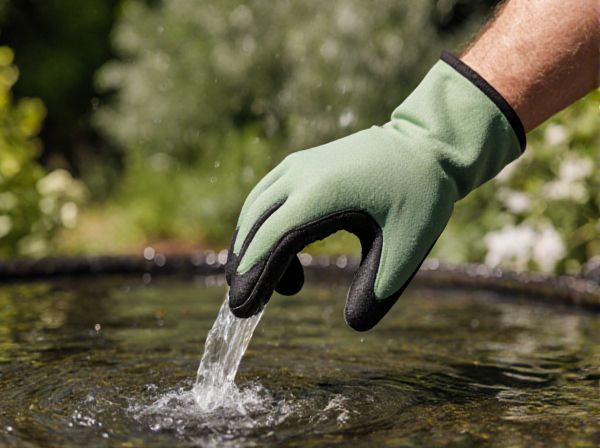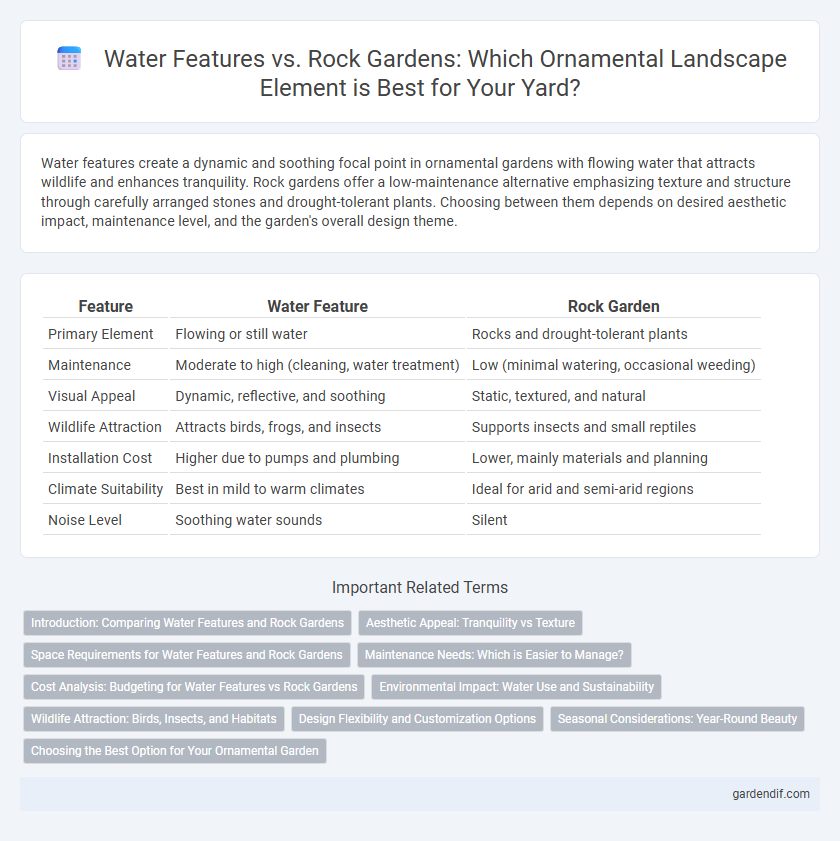
Water Feature vs Rock Garden Illustration
Water features create a dynamic and soothing focal point in ornamental gardens with flowing water that attracts wildlife and enhances tranquility. Rock gardens offer a low-maintenance alternative emphasizing texture and structure through carefully arranged stones and drought-tolerant plants. Choosing between them depends on desired aesthetic impact, maintenance level, and the garden's overall design theme.
Table of Comparison
| Feature | Water Feature | Rock Garden |
|---|---|---|
| Primary Element | Flowing or still water | Rocks and drought-tolerant plants |
| Maintenance | Moderate to high (cleaning, water treatment) | Low (minimal watering, occasional weeding) |
| Visual Appeal | Dynamic, reflective, and soothing | Static, textured, and natural |
| Wildlife Attraction | Attracts birds, frogs, and insects | Supports insects and small reptiles |
| Installation Cost | Higher due to pumps and plumbing | Lower, mainly materials and planning |
| Climate Suitability | Best in mild to warm climates | Ideal for arid and semi-arid regions |
| Noise Level | Soothing water sounds | Silent |
Introduction: Comparing Water Features and Rock Gardens
Water features enhance ornamental landscapes by incorporating dynamic elements like fountains, ponds, and waterfalls that create soothing sounds and attract wildlife. Rock gardens offer a contrasting aesthetic with carefully arranged stones, drought-tolerant plants, and minimalist design emphasizing texture and form. Both water features and rock gardens serve as focal points in garden design, providing unique sensory experiences and environmental benefits.
Aesthetic Appeal: Tranquility vs Texture
Water features enhance aesthetic appeal by introducing dynamic movement and soothing sounds that promote tranquility and relaxation in ornamental spaces. Rock gardens emphasize texture and visual contrast through varied stone shapes, sizes, and colors, creating a rugged yet harmonious landscape element. Combining water features with rock gardens can elevate outdoor design, balancing serene ambiance with tactile visual interest.
Space Requirements for Water Features and Rock Gardens
Water features typically require more space due to the need for a basin, plumbing, and surrounding clearance for safety and maintenance, often demanding at least 15-30 square feet. Rock gardens are more adaptable to smaller or irregular spaces, utilizing varied rock sizes and drought-resistant plants to create a compact, low-maintenance display. Proper planning of spatial dimensions ensures both water features and rock gardens integrate seamlessly into ornamental landscape designs.
Maintenance Needs: Which is Easier to Manage?
Water features require regular cleaning, pump maintenance, and monitoring water quality to prevent algae growth, making them more labor-intensive than rock gardens. Rock gardens typically need minimal upkeep, mostly involving occasional weeding and adjusting stones, offering a low-maintenance alternative. Choosing between them depends on desired aesthetic and time available for routine care.
Cost Analysis: Budgeting for Water Features vs Rock Gardens
Water features generally require a higher initial investment, with average costs ranging from $2,000 to $10,000 depending on size and complexity, compared to rock gardens which typically cost between $500 and $3,000. Maintenance expenses for water features are also significantly higher due to the need for pumps, filters, and regular cleaning, while rock gardens incur minimal upkeep costs involving occasional weeding and replacement of rocks. Budget-conscious landscaping projects often favor rock gardens for their affordability and lower operational expenses, whereas water features serve as luxury focal points that elevate property value despite higher costs.
Environmental Impact: Water Use and Sustainability
Water features typically consume significant amounts of water, impacting local water resources and increasing maintenance needs, whereas rock gardens require minimal to no water, promoting sustainability. Rock gardens support biodiversity by providing habitats for drought-tolerant plants and reducing soil erosion, while water features may contribute to water evaporation and chemical use. Choosing rock gardens over water features can enhance environmental conservation by conserving water and minimizing ecological disruption.
Wildlife Attraction: Birds, Insects, and Habitats
Water features create dynamic habitats that attract a variety of birds and beneficial insects by providing a reliable source of water and shelter. Rock gardens support wildlife by offering crevices for insects and small animals to nest, offering a dry refuge that complements the moisture around water features. Incorporating both elements enhances local biodiversity, fostering diverse and sustainable wildlife environments.
Design Flexibility and Customization Options
Water features offer extensive design flexibility with customizable elements such as cascading waterfalls, fountains, and lighting effects that can adapt to various garden sizes and styles. Rock gardens provide versatility through the arrangement of diverse stone types, textures, and alpine plants, allowing for tailored natural aesthetics and low-maintenance landscapes. Both water features and rock gardens enable unique customization, but water elements often require more technical installation and ongoing care compared to the simpler, eco-friendly customization of rock gardens.
Seasonal Considerations: Year-Round Beauty
Water features maintain year-round beauty by providing dynamic movement and reflections that adapt with each season, enhancing garden aesthetics through changing light and weather conditions. Rock gardens offer low-maintenance charm with evergreen structural appeal, but may require seasonal planting adjustments to maintain vibrancy. Selecting between the two depends on climate durability and gardener preference for seasonal visual interest versus consistent, natural stone appeal.
Choosing the Best Option for Your Ornamental Garden
Water features create dynamic focal points with flowing water that attracts wildlife and enhances tranquility, ideal for gardens emphasizing movement and sound. Rock gardens offer low-maintenance beauty with diverse textures and natural stone arrangements perfect for drought-resistant landscapes and minimalist designs. Selecting the best option depends on climate, maintenance preferences, and the desired aesthetic impact within your ornamental garden.
Water Feature vs Rock Garden Infographic

 gardendif.com
gardendif.com